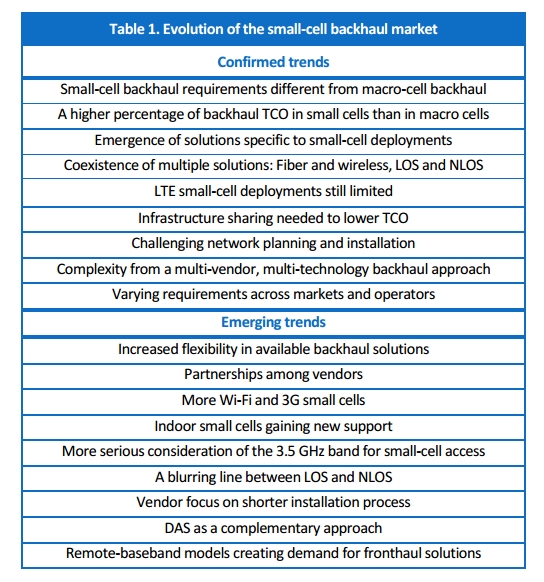Welcome to Smallville
Small-cell backhaul
There are several differences between managing backhaul for small cells as opposed to macrocells. For example, backhaul contributes to a larger percentage of the total cost of ownership (TCO) of small cells; their compact size, ease of installation and low power requirements are contributing to their use in remote, rural locations, which are typically hard to reach with terrestrial cabling. Operators in some regions, particularly Europe, are combining their network assets and implementing RAN (radio access network) sharing, which can create plug-and-play challenges. The ease with which small cells can be integrated into existing networks and connected to the network core is directly related to how quickly they can be deployed.
Emerging trends that will drive innovation as well as the growth of the small-cell market in general are increased vendor partnerships, wholesale Wi-Fi integration and greater flexibility in small-cell gateways. The state of the small-cell backhaul market can be seen in figure 3 below.
 Source: Senza Fili Consulting, 2013
Source: Senza Fili Consulting, 2013
Jersey Telecom case study
Jersey Telecom provides wireless service for customers who live on the small island of Jersey, located off the northern coast of France. In order to boost indoor coverage and reduce the strain on macrocell sites, JT looked to small cells, but first-generation solutions proved too expensive, and there were concerns about how easily the tiny devices would integrate into the provider’s legacy network.
When JT discovered an evolved solution from ip.access, it was able to move forward with its small-cell rollout. This next-generation solution enables operators to manage 2G, 3G and 4G small cells from a converged gateway.
“We have looked at small-cell solutions before, but the entry-level costs associated with other solutions in the market have previously made the economics difficult. The ip.access nanoConverge 200 removed that barrier,” said Tim Knights, head of mobile networks for Jersey Telecom, in a July press release. “What’s particularly pleasing is how well the ip.access small cells have integrated into our macro network, and we will now be accelerating our rollout of the service across the island, targeting busy and hard-to-reach locations.”
Welcome to smallville
If you think you know small cells, think again. The technology has rapidly evolved over the past two years, and Infonetics analyst Stéphane Téral predicted that 2013 would be “a kick-off year for small cells.”
Next-generation small cells sport increased capability, flexibility and manageability, and should be part of any discussion of network expansion. Outdoors, small cells enable MNOs to increase coverage in high-traffic areas, hit hard-to-reach locales and reduce strain on macrocell sites, while indoors, they turn “not” spots into hotspots and enable the pervasive, high-speed connectivity that consumers have come to expect, particularly business customers.
The small-cell revolution is driving new market opportunities as well, including premium service offerings for residential, hospitality and business customers. The cost of deploying these diminutive devices—including the TCO—is changing, and the ease at which they integrate into legacy networks is improving. There’s a good chance that some of the biggest network challenges today can be solved by the smallest network elements.



















